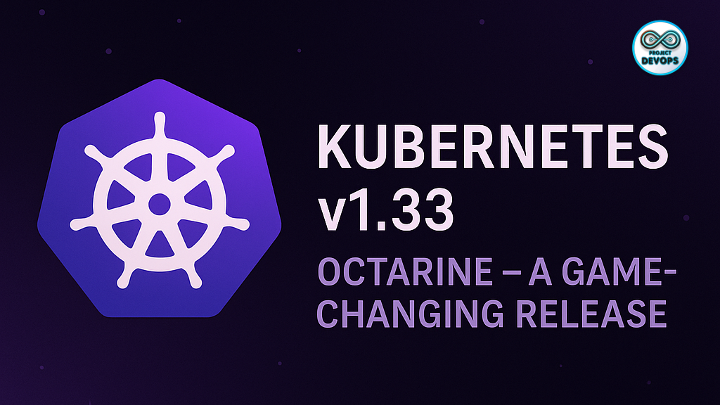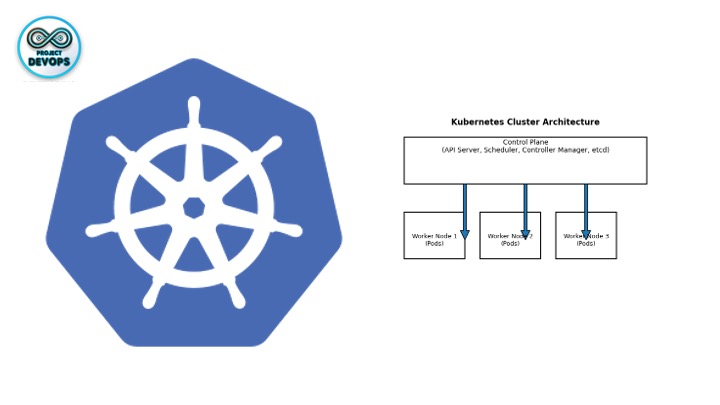Kubernetes v1.33 “Octarine" – A Game-Changing Release

Kubernetes v1.33 “Octarine” – A Game-Changing Release
Kubernetes v1.33, released on 23 April 2025, is codenamed “Octarine: The Color of Magic.”
The release cycle lasted 15 weeks (13 Jan – 23 Apr 2025) and involved 570 contributors from 121 companies. It delivers 64 enhancements (18 stable, 20 beta, 24 alpha) targeting scalability, security, usability, and developer experience.
For DevOps engineers balancing efficiency, security, and reliability, this release introduces features like native sidecars, dynamic resource scaling, and user namespaces by default, making it a true milestone.
From v1.32 (Penelope) to v1.33 (Octarine)
Kubernetes v1.32 “Penelope” (Dec 2024) focused on stability and storage management, introducing:
Single-process OOM kill – kubelet kills only the offending process during OOM instead of the entire container.
Auto-remove PVCs – StatefulSets clean up unused PVCs.
Dynamic Resource Allocation (DRA) improvements – structured parameter support for the scheduler.
Memory manager GA – better memory allocation across NUMA nodes.
These laid the groundwork for v1.33’s breakthroughs in live scaling, isolation, and scheduling.
Key Stable Enhancements in v1.33
1. Native Sidecar Containers (GA)
The sidecar pattern is now a first-class citizen. Sidecars:
Start before app containers.
Run continuously with restartPolicy: Always.
Use readiness/liveness probes.
Example:
Running a logging sidecar with Fluent Bit alongside your main Nginx container:
apiVersion: v1
kind: Pod
metadata:
name: web-with-logger
spec:
initContainers:
- name: sidecar-logger
image: fluent/fluent-bit:latest
restartPolicy: Always
containers:
- name: nginx
image: nginx:latestThis ensures logs are always collected without hacks.
2. Backoff Limits per Index & Job Success Policy (GA)
Indexed Jobs now support per-index retry limits and success policies.
Example:
Run a simulation where only one index must succeed:
apiVersion: batch/v1
kind: Job
metadata:
name: simulation
spec:
completions: 10
backoffLimitPerIndex: 3
successPolicy:
type: Indexed
indexes: ["0"] # Job succeeds if index 0 finishes3. Bound Service-Account Token Improvements (GA)
Service account tokens now include:
Unique JTI (token ID).
Node-specific binding.
Example use case:
You can restrict a token to only be valid on Node worker-1. This reduces lateral movement risks in compromised clusters.
4. Multiple Service CIDRs & Subresource Support (GA)
Clusters can allocate Service IPs from multiple CIDR ranges, avoiding IP exhaustion.
Example:
apiVersion: networking.k8s.io/v1
kind: ServiceCIDR
metadata:
name: extra-service-cidr
spec:
cidrs:
- 10.97.0.0/16Also, kubectl --subresource lets you patch status directly:
kubectl patch deployment myapp --subresource='status' \
-p '{"status":{"availableReplicas":2}}'5. nftables Backend & Topology-Aware Routing (GA)
nftables backend → more scalable alternative to iptables.
PreferClose traffic distribution → keep traffic within the same AZ.
Example:
A multi-zone Service routes traffic to the closest backend, reducing egress costs in AWS/GCP.
Beta Features: Live Scaling & Better Isolation
1. In-Place Pod Resource Resize (Vertical Pod Autoscaling)
You can now resize CPU/memory of a running pod without restarting it.
Example:
kubectl patch pod myapp-123 --type='merge' \
-p '{"spec":{"containers":[{"name":"myapp","resources":{"requests":{"memory":"2Gi"}}}]}}'This eliminates downtime for memory-intensive stateful apps like databases.
2. User Namespaces Enabled by Default
Pods can run as root inside the container while being mapped to an unprivileged UID on the host.
Example:
securityContext:
runAsUser: 0 # root inside
runAsNonRoot: true # mapped to non-root outsideThis prevents privilege escalation attacks.
3. Image Volumes (Beta)
Pods can mount OCI images as volumes, separating tools from app images.
Example:
volumes:
- name: tools
csi:
driver: image.csi.k8s.io
volumeAttributes:
image: myorg/debug-tools:latestThis lets you inject debugging binaries without bloating your main image.
Alpha Features: Future Directions
Some experimental capabilities:
Custom stop signals – define how containers should terminate.
Configurable HPA tolerance – fine-tune scaling oscillations.
Secret-less image pulls – kubelet fetches tokens automatically.
PSI (Pressure Stall Information) – advanced scheduling signals.
These require feature gates enabled explicitly.
Deprecations & Removals
Endpoints API → replaced by EndpointSlices.
gitRepo volume driver → removed (use initContainers + git-sync).
status.nodeInfo.kubeProxyVersion → dropped due to inaccuracy.
Why v1.33 Is a Game-Changer for DevOps
Seamless Scaling
Resize pods live → better elasticity for apps like Redis or Kafka.
Stronger Security
User namespaces, node-scoped service tokens, ClusterTrustBundles → safer multi-tenant clusters.
Improved Scheduling
NUMA-aware CPU assignment and topology-aware routing → lower latency for ML/AI workloads.
Better Developer Experience
Sidecars as stable, image volumes, kubectl subresources → fewer hacks, faster iteration.
Conclusion
Kubernetes v1.33 “Octarine” transforms patterns like sidecars into stable primitives, enables in-place vertical scaling, and strengthens isolation with user namespaces by default. It streamlines networking, scheduling, and job management, while also cleaning up deprecated APIs.
For DevOps teams, this release marks a new phase: clusters that scale live, isolate securely, and optimize resources intelligently.
Read the official release notes at kubernetes.io.
Comments (0)
No comments yet. Be the first to share your thoughts!
